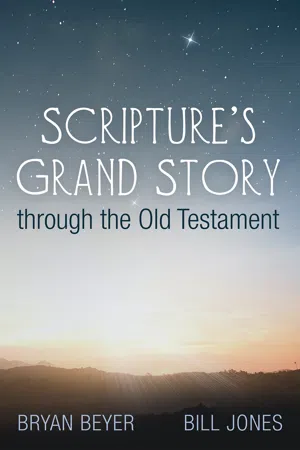![]()
Part One
The Torah (“Instruction”)
Also sometimes called the Law,the Pentateuch (“five scrolls”), or the Five Books of Moses (Israel’s great leader)
Books Covered
Genesis
Exodus
Leviticus
Numbers
Deuteronomy
![]()
1
Genesis
The first five books of the Bible—Genesis, Exodus, Leviticus, Numbers, and Deuteronomy—are also sometimes called the Pentateuch or Torah. Pentateuch comes from two Greek words and means “five scrolls,” a term that highlights the original format for these books. The word Torah literally means “teaching” or “instruction,” and sometimes translators render it “law.” The Bible affirms in many places that Moses, Israel’s great leader, was responsible for the composition of these five books. We’ll learn more about Moses in the chapter on Exodus.
The book of Genesis divides into two major parts, though the parts are not equal in length. Genesis 1–11 highlights what many Bible scholars have called the primeval history, a period of time in which key events lay a foundation for the rest of God’s story. The second part of Genesis, Genesis 12–50, has often been called the patriarchal narrative and describes the founders of the Jewish faith as God began to carve out a people for his name. Genesis 1–11 contains four key events: creation (chs. 1–2), the fall (chs. 3–5), the flood (chs. 6–9), and the tower of Babel (chs. 10–11).
Primeval History (Gen 1–11)
Creation (Gen 1–2)
Many ancient Near Eastern societies wrote their own creation accounts. In general, however, all of those creation accounts described many gods who together brought the world and humanity into existence. Genesis 1, however, records the deliberate actions of an all-knowing God—one God—who both spoke the universe into existence and then created the matter from which he would form everything. Genesis 1 lays out a careful sequence God established to put everything in its place. Scholars have interpreted these verses of Genesis in different ways. Some view the six days of creation as literal six-day periods. Others interpret them as periods of time. Regardless of what interpretation we take on this issue, what remains clear in Genesis 1 is that the creation of the world is the creation brought about by one God, not many, and that our God is a God of order, not of chaos.
Genesis 1:1—2:4 records the big picture of God creating the world and placing humanity in it. Genesis 2 provides somewhat of a zoom lens approach, where the text zooms in on particular details of the creation of man and woman as parents of the human race. The Lord formed man from the ground and woman from man. At the end of Genesis 2, Adam and Eve, humanity’s first couple, stood together in a perfect world.
God had given humanity the responsibility to till the garden of Eden in which he had placed them. In the midst of that garden lay the tree of the knowledge of good and evil, a tree from which God commanded them not to eat. If they did, they would be doomed to die. What happened with regard to that tree is described in the next section.
The Fall (Gen 3–5)
Genesis 3 records the sad fall of humanity into sin. The text records a dialogue between Eve and a deceptive serpent whom Scripture later identifies as Satan. The serpent subtly twisted God’s words, assuring Adam and Eve they would become like God, knowing good and evil. The text records the fateful moment when, after contemplating the desirability of the fruit, they partook of it together (Gen 3:6). Both Adam and Eve now knew good and evil firsthand and experientially knew evil for the ugly thing it was. The text records how God banished Adam and Eve from the garden of Eden, an action that really involved a measure of grace, so that they would not lay hold of the tree of life and live forever (Gen 3:22). He also spoke words of consequence to the woman and man but words of judgment to the serpent. One day, the seed of the woman would crush the serpent forever (Gen 3:16). Perhaps Adam and Eve wondered if the serpent’s destruction would mean that one day, God would let them return to Eden. Indeed, the rest of the Bible points to a great day when God will give his people a new world in which to live. However, the end of the story reveals he has something much greater than the garden of Eden to give us.
Adam and Eve began life apart from the garden of Eden in chapter 4, which records the birth of their two sons Cain and Abel. The sad truth of sin’s ugliness is highlighted when sin led to murder in one generation, as Cain became jealous of Abel and killed him. Cain then fled the area, leaving Adam and Eve bereaved of both their sons in one day. However, God’s grace began anew for Adam and Eve with ...
